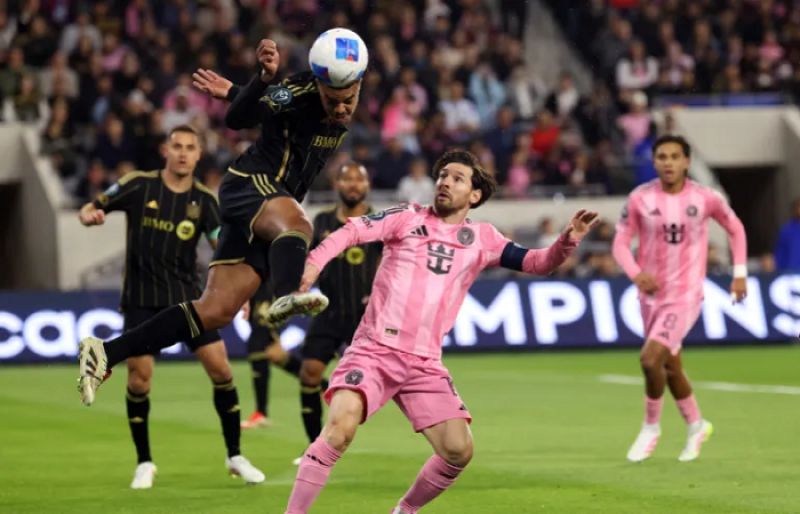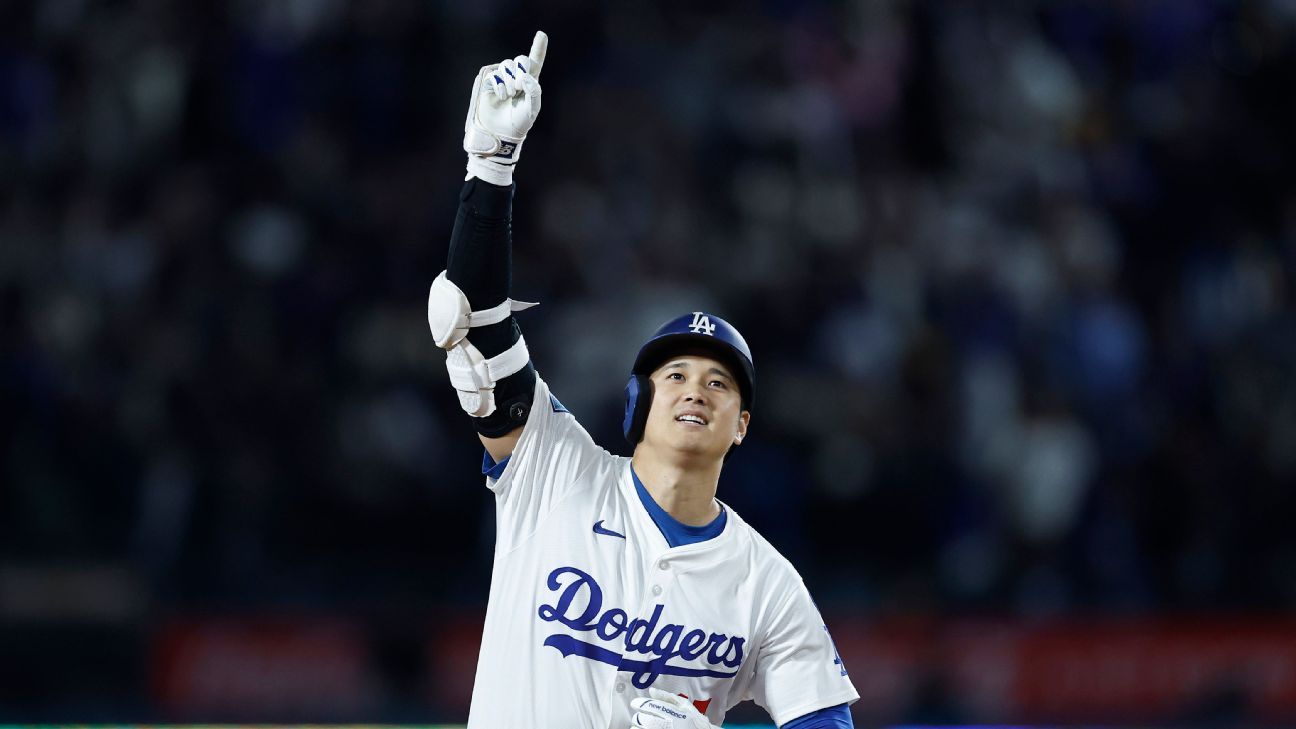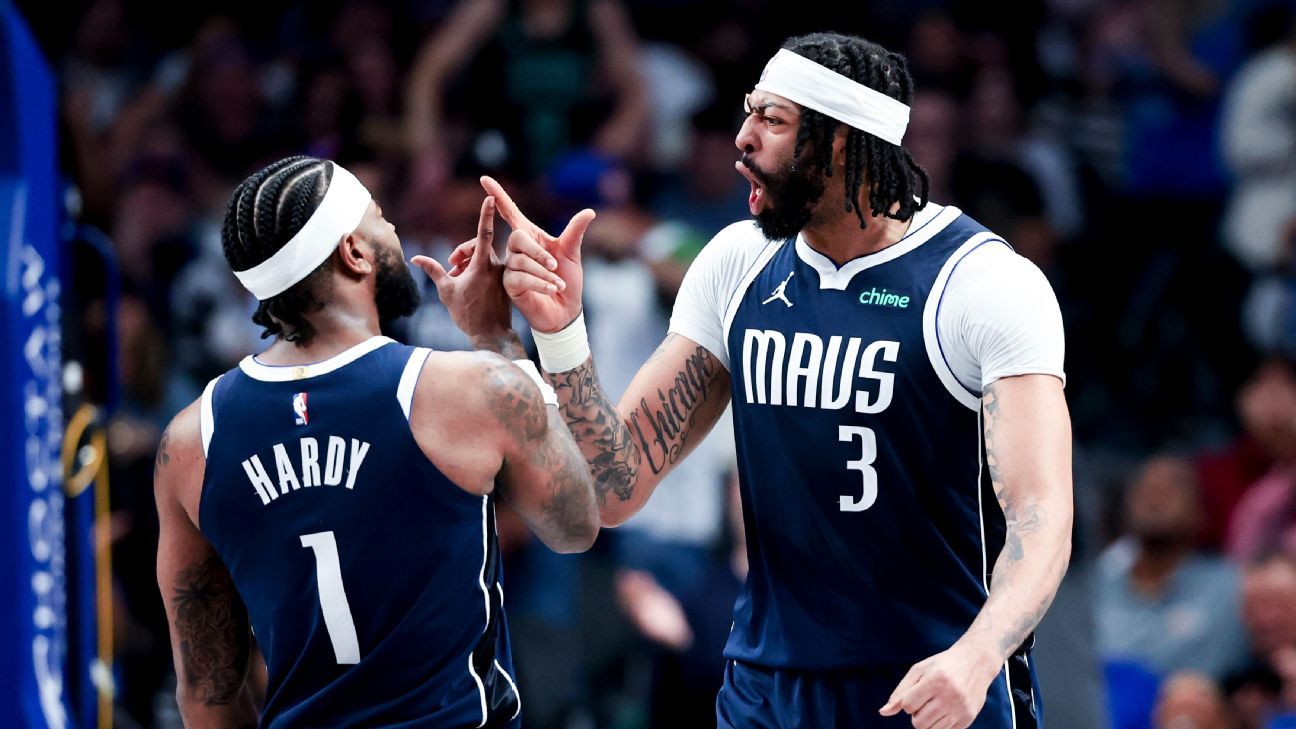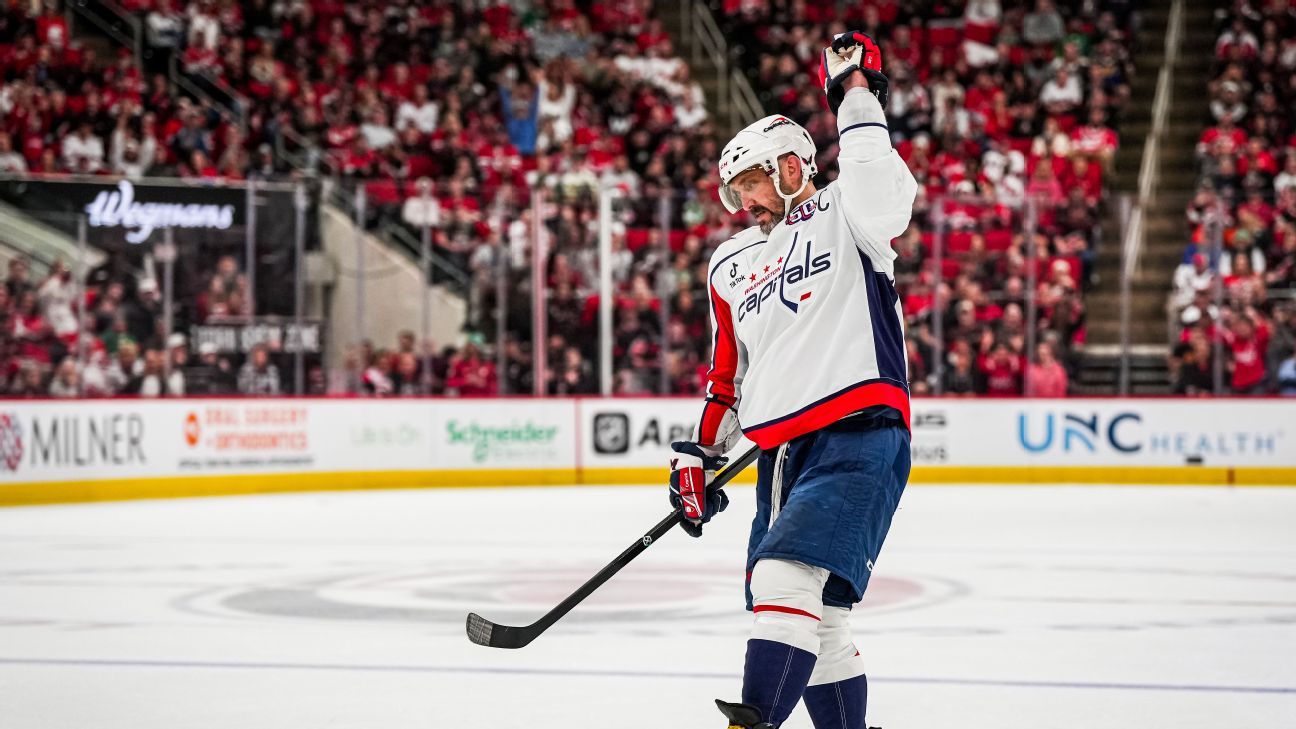
Why Ovechkin is ‘nearly impossible’ to stop: Opponents, teammates explain his shot
Washington Capitals coach Spencer Carbery smiles while discussing “the few faceoff plays” they run for Alex Ovechkin.
When it’s from the right circle, the Capitals call it “Shooter Back.” From the left circle, they call it “Board Side O” — as in, “board side Ovechkin.” Numerous goals have come from these play designs, which have been so successful that every other team in the NHL has its own version — albeit without Ovechkin on the finishing end.
Ovechkin’s legacy is about scoring goals — as he closes in on Wayne Gretzky’s record of 894 — and these plays are an instrumental part of that legacy. So much so that the area in the left faceoff circle has become known as “Ovi’s Office.”
Ovechkin became synonymous with faceoff goals because of the play designs and his ability to get a shot off whether the puck is flat or wobbly. There’s also the Capitals’ ability — even as Ovechkin gets older — to supply him with a certain archetype of teammate that has helped foster continuity and make adjustments as he approaches the record. “The reality is all you’re trying to do is get the puck in his hands, on his stick, and let him get a clean shot off anywhere inside the top of the circles,” Carbery said.
Ovechkin scored his first NHL goal on Oct. 5, 2005. That was before leading rookie of the year contender Macklin Celebrini was born — his birthday is June 13, 2006. Ovechkin can score from anywhere on the ice, but the faceoff circle is where he has done much of his damage — 210 of them since 2007-08, according to MoneyPuck data.
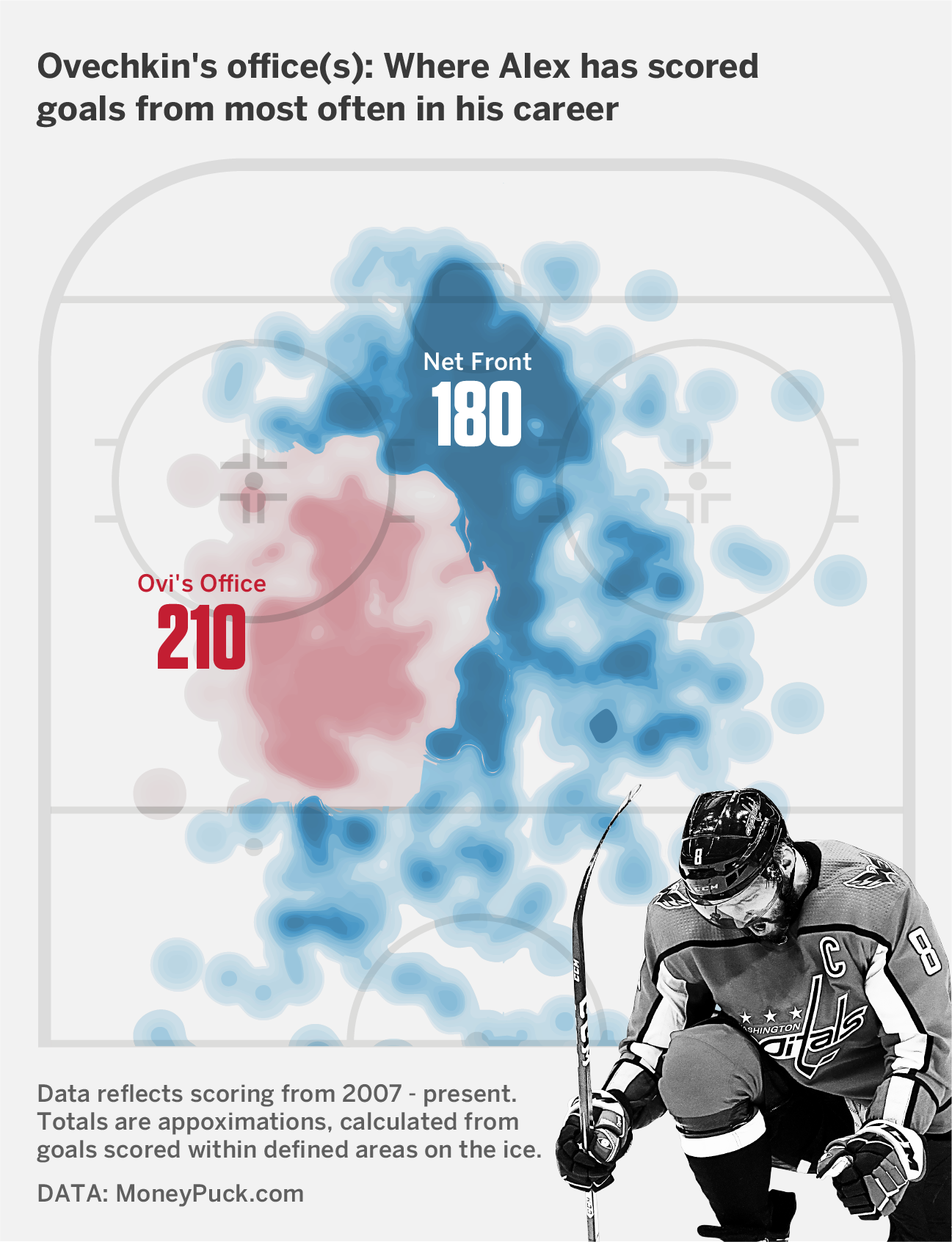
Multiple coaches and players from across the NHL agreed Ovechkin’s pursuit of Gretzky’s record is a testament to consistency — not just for Ovechkin, but the Capitals, who are still placing their franchise’s all-time greatest player in a position to succeed.
“One of the things that’s not talked about a ton with the reason he’s had faceoff circle success is he’s pretty much always had a left-handed centerman,” one NHL assistant coach said. “Now, it’s Dylan Strome. Before that, it was Evgeny Kuznetsov and Nicklas Backstrom. It works out really well because he’s a right-handed shot and they’re pulling out on to his forehand. If he had a right-handed center, it would be even more difficult for those plays to work.”
After nearly two decades, through a career that started in the dead puck era and continues with the net front now en vogue, nobody has found a way to consistently prevent Ovechkin from scoring from the faceoff circle — even though everyone in the building knows where he’s going to set up. As those around the NHL explain it, there are so many decisions opponents must make — and moving parts to be accounted for — that it will lead to Ovechkin and the Capitals inevitably finding an advantage.
“He’s probably going to be the best goal scorer in history, which makes it the hardest job to defend him,” Anaheim Ducks defenseman Radko Gudas, who was Ovechkin’s teammate in the 2019-20 season, said. “It’s really about anticipating and not giving him as much space as he wants. But for some reason, he keeps finding it and keeps scoring goals.
“In the first game I ever played against Washington, he scored four goals, and you’re just asking, ‘How did this happen?'”
WHAT EXACTLY MAKES “Board Side O” so hard to stop? The assistant coach explains it using a series of video clips. The first starts with Strome, a left-handed center, winning the faceoff. Once the draw is done, Ovechkin is already within 5 inches of the puck.
The coach said Ovechkin not only gets off the line quickly, he is usually moving before his opponent. This allows him to create separation, and it’s a recipe he has perfected over his 20-year career.
But it’s not just that early separation. The coach points out how the puck is wobbling and difficult to control. Still, Ovechkin fires on net without needing even half a second to get off a perfect shot.
“Ninety-nine percent of the league, the moment this puck is fumbled, it’s not a shot on goal, it’s not a scoring chance,” the assistant said. “He finds a way to get pucks through no matter what. That’s an elite skill that he has that’s just as good or better than anyone else in the league has.”
The assistant shows more clips of “Board Side O” before switching to footage of what makes “Shooter Back” equally successful on the other side of the ice. With the faceoff on the right side, Ovechkin is on the inside part of the ice. He still has a left-handed center pulling the puck toward him and he instantly fires a shot with another rolling, wobbly puck that beats the goalie.
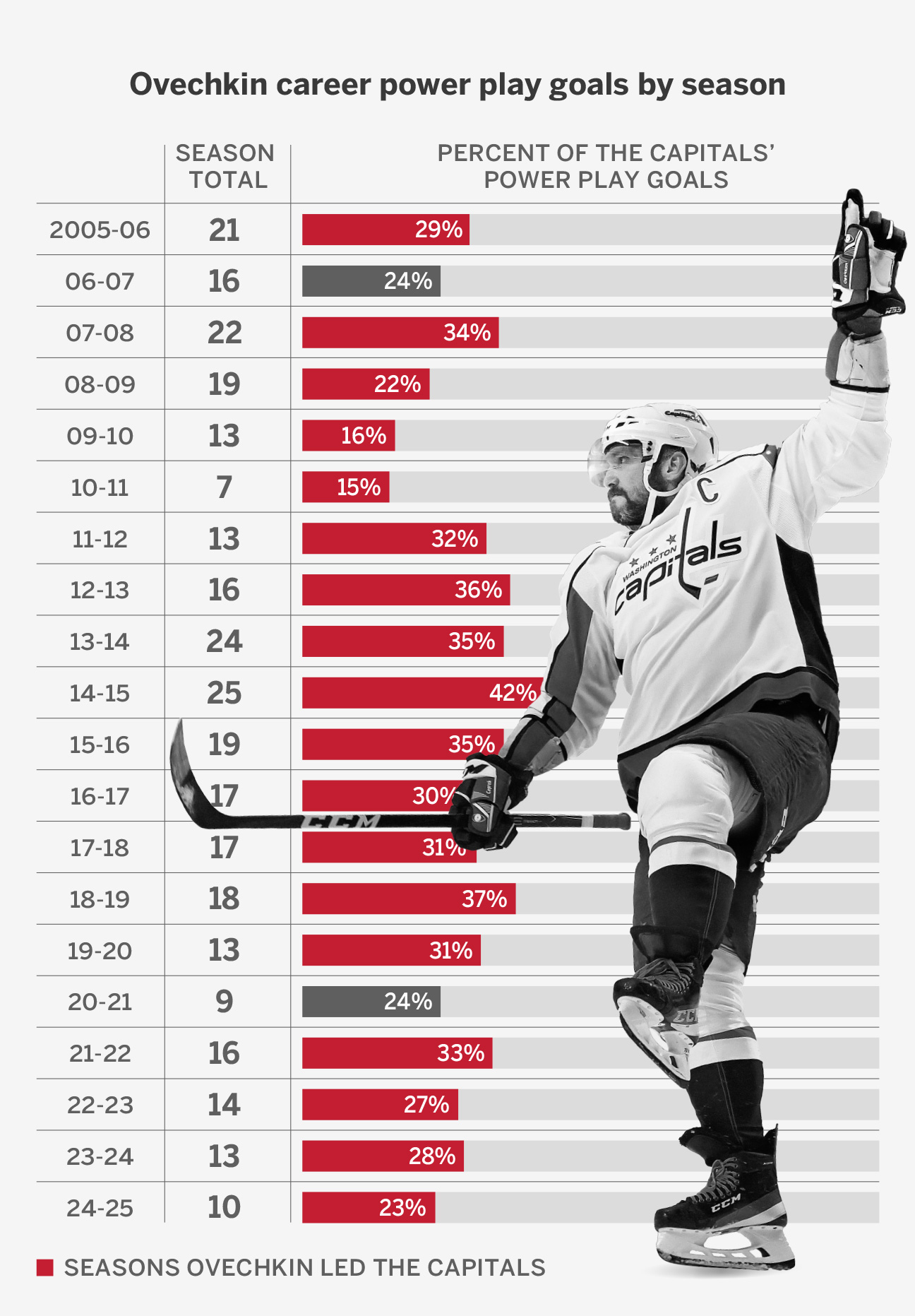
Steven Stamkos — tied for 22nd all-time with 577 goals — said there are numerous moving parts that must fall into place to score from the faceoff circle. The shooter needs playmakers who can distribute, and he needs to find space to get to the faceoff circle. Being in the right position leads to east-to-west passes, which result in shots that are hard for the goalie to stop.
He added that the speed of the pass often dictates where the shooter aims. But the goal is to fire the puck so quickly that the goalie doesn’t have time to react.
“The faceoff dot, per se, between the hashmark is kind of like the quiet area in the defensive zone,” Stamkos said. “For him and I, it’s a spot where we’ve had a lot of success and you just keep going back to what works.”
What Ovechkin does with his shot prompted the assistant to compare Ovechkin to a baseball player. He said many NHL players practice one-timers with the idea that if the puck is off by 6 inches, they won’t take the shot. Ovechkin will take the shot.
“If you groove a fastball down the middle, any guy can hit that,” the assistant said. “What about a pitch on the edge of the strike zone? That’s what Ovechkin does so well. He can hit all those pitches.
“He can take those imperfect passes and not only get pucks on the net, but he can get them through defenders and put them in a difficult place for a goalie to save.”
OVECHKIN’S PRODUCTION FROM the faceoff circle has stirred debate on what qualifies as a high-danger scoring chance. Because if it’s Ovechkin in the faceoff circle? That’s about as dangerous as it gets.
“The thing with him is he doesn’t need much space,” Nashville Predators defenseman Roman Josi said. “You just need to be one second late and he’s going to score.”
Anyone who has watched Ovechkin has seen what this looks like; he finds space in the faceoff circle before dropping to one knee and blasting a one-timer that’s usually followed by him celebrating.
Barry Trotz, who coached Ovechkin for four seasons including winning the Stanley Cup in 2018, said the Caps’ power play is designed to create two choices for opponents: focus on Ovechkin and leave everyone else open, or concentrate on the other four skaters with the hopes none of them can get the puck to Ovechkin.
Each choice provides a problem. Those playmaking centers are either going to find someone else, or they can score themselves. There are also the puck-moving defensemen with hard shots, like Mike Green and John Carlson, while wingers such as T.J. Oshie, Alexander Semin and Tom Wilson have occupied different spaces — and scored many goals.
“They’ve been so good for so long, and he’s a much better passer than people realize,” Trotz said of Ovechkin, who is 56th in NHL history with 724 assists. “If he knows he can’t get the puck through, he’s a good passer as well and doesn’t get enough credit for that.”
Tampa Bay Lightning defenseman Ryan McDonagh said there’s a reason penalty killers are still trying to figure out Ovechkin.
“Guys like him and [Stamkos] like to shoot it, they like to establish their shot but they also know a lot of times there’s going to be a guy in the lane blocking the shot and somebody else might be open,” McDonagh said. “They have the ability to find that passing lane and create a scoring chance for someone else.”
Lightning goaltender Andrei Vasilevskiy said Ovechkin’s shot is both powerful and the hardest to track in the NHL, comparing it to a knuckleball that somehow moves at a high rate of speed.
Vasilevskiy said that while goalies are trained to stop flat shots at various speeds, the movement and power Ovechkin generates can’t really be replicated. That’s because it changes direction “at least three or four times” before reaching the net, he said.
“Even when it’s flat, it’s hard to stop,” Vasilevskiy said. “But when it’s a knuckleball, it’s nearly impossible. You’re just trying to get in a good position and hope to block it. There’s no chance to react against such a shot.”
Josi added that it’s also a very difficult for a defenseman to block.
“It is heavy. But at the same time while it’s heavy, he also knows where it’s going,” Josi said. “A lot of times, I think he knows when you’re trying to block it and he finds a way to get around it.”
INJURIES TO BACKSTROM and Oshie, along with Kuznetsov being traded last spring, meant the Capitals were in transition. They still reached the playoffs in 2023-24 as a wild-card entry, ranking 18th on the power play (20.6%) and 28th in goals per game (2.63).
The changes impacted Ovechkin’s production. He finished with 31 goals and 65 points, which are the lowest totals he has recorded in each category for a single season in which he played more than 70 games.
This season, the Capitals are atop the Eastern Conference standings, and leading the NHL with 3.58 goals per game while their power play is ninth, with a 23.7% success rate.
“You can’t just plug someone in and expect them to be Nicklas Backstrom,” Carbery said. “He is so gifted and talented in that area that it’s unfair to say, ‘Dylan Strome, go be Nicklas Backstom.’ His skill set is different. We had to go through a process of trial and error. We had to learn that for ourselves. Everyone said, ‘Let’s do it the way we’ve done it for 10 years because that’s been so successful’ — but that’s not the way it works.”
Strome said in his first couple games, he always looked for Ovechkin no matter where they were on the ice. That’s what Strome did when he played alongside Patrick Kane when he was with the Chicago Blackhawks.
But what Strome learned was that he now has the freedom to carry the puck into the offensive zone. Then, it’s about finding Ovechkin in different spaces.
“Whenever you are playing with someone who has those guys’ skill level, your senses are heightened and you want to get them the puck whenever you can,” Strome said. “You want to be a complementary piece to those guys who’ve done it a long time. Those guys are always at the top of their game and it puts that extra pressure on you to make sure you play well enough so they want you on their line.”
Natural Stat Trick’s metrics show Strome has played more than 480 minutes in 5-on-5 play with Ovechkin this season. Ovechkin has had 88 minutes when he hasn’t played with Strome at 5-on-5, while they’ve spent more than 142 minutes together on the power play.
Wilson, who has been with the Capitals for 12 seasons, said playing with Ovechkin is all about how one understands space. He said that his role from the moment he joined the team was to do whatever he could to either create space for Ovechkin or find Ovechkin in those spaces by constantly forechecking to win possession.
Talking about the time they played together, Wilson joked that together they provided “a lot of body” for opponents. Ovechkin stands at 6-foot-2 with a playing weight between 220 and 238 pounds, while Wilson is 6-4 and 220 pounds.
“He also creates a lot of room,” Wilson said. “Everyone assumes when he gets the puck, that he’s going to shoot. I’ve had a ton of goals in my career where he finds me. He doesn’t shoot it, but he passes. I’ve had a lot of benefits from him being able to find me on the backdoor or in the slot. But his shot is a cheat code because it does open everything up.”
Carlson and Wilson have seen Ovechkin score hundreds of times, but they both said this season has been so much fun to watch. They talked about how every arena they go to is filled with people who want to see Ovechkin get closer to a record.
The desire to be on the ice for the record-breaking goal has led to some lobbying by players, which makes Carbery smile.
“Oh, of course!” Carlson said when asked if he wants to have a hand in Ovechkin’s historic goal. “I think everybody does. I think that’s on everyone’s mind.”
Wilson said: “Everyone wants to be a part of history and everyone will be a part of history. It doesn’t matter who’s on or who passes it. I just think being able to tell your kids about that one day and being a part of it is going to be something I’ll never forget.”





